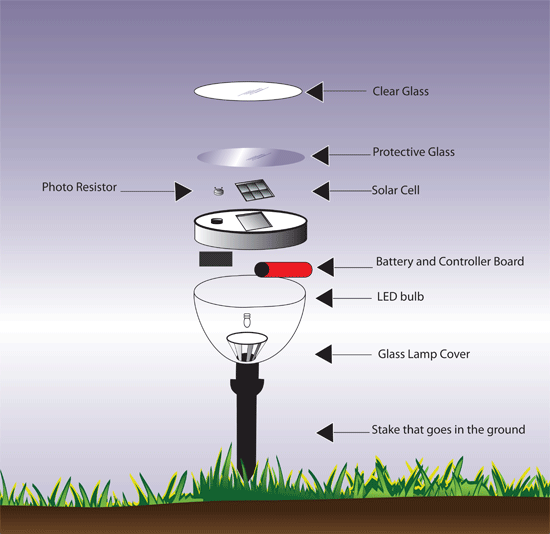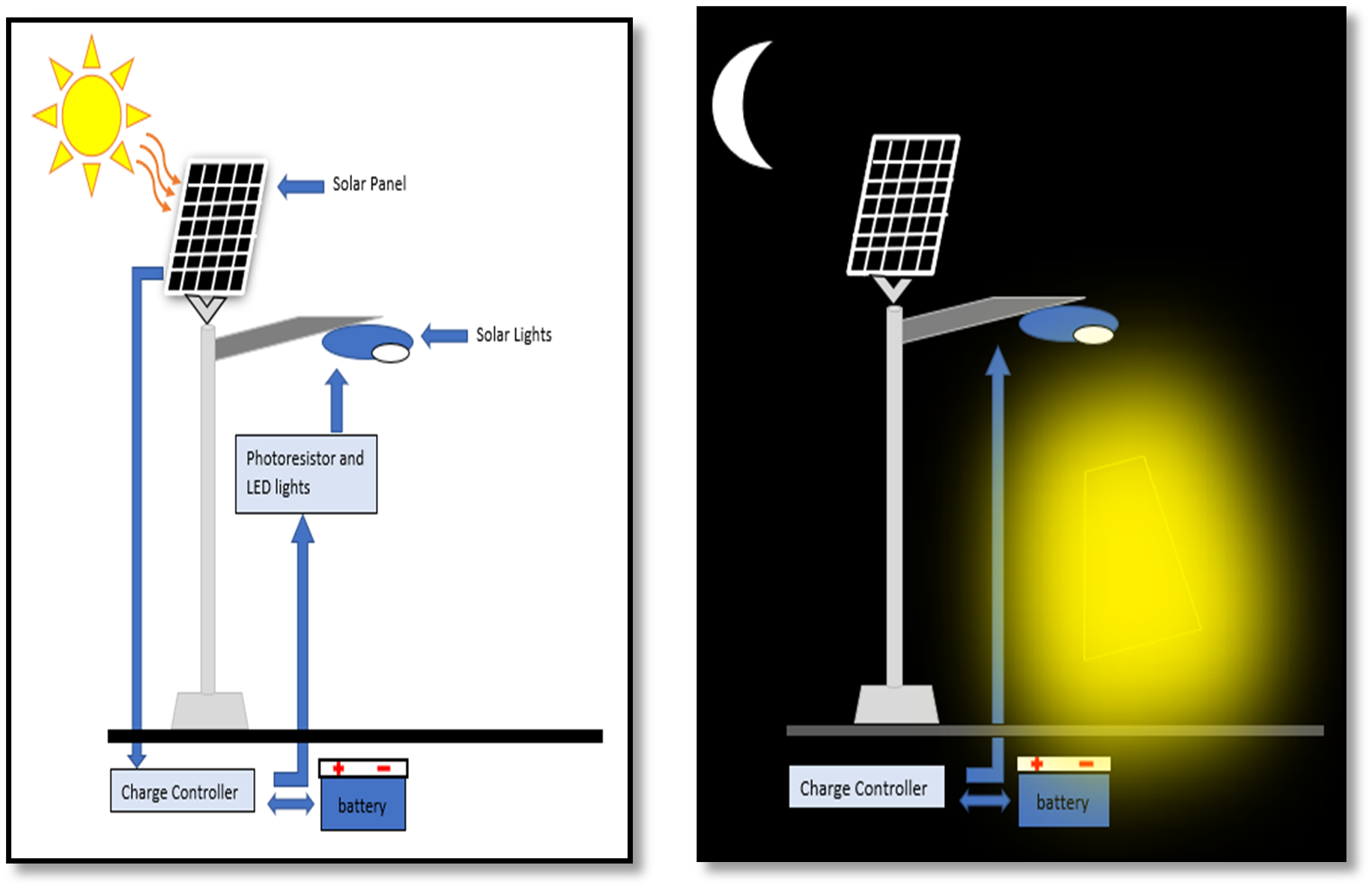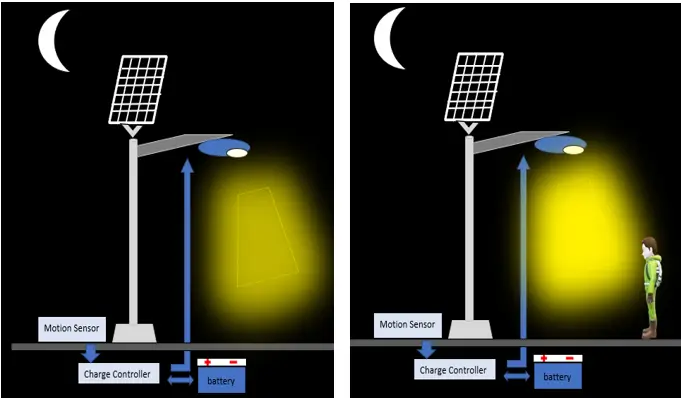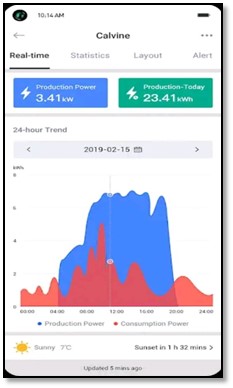This guide discusses how do solar lights work?
Solar lights use the photovoltaic (PV) effect to generate energy. The PV effect is a process where solar cells absorb sunlight and convert it into electrical energy.
The electrical energy generated charges the battery through a controller, which powers up the LED lights at night.
The lights remain off during the day and turn on at night due to the photoresistor.

Components Required
Designing and implementation of solar lights require the following components:
Solar panel: A mounted solar panel should be placed at the top of your light at a suitable angle to receive maximum sunlight.
Solar Lights: Multiple LED lights connected parallel to each other and placed at positions that allow them to cover maximum distance. The solar lights should be equipped with a photoresistor to differentiate between daytime and nighttime.
Controller: A controller acts as the brain of a circuit. Its purpose is to manage light output and battery management.
Battery: Lithium-ion (Li-ion) battery, Nickel Metal Hybrid (NiMH) battery, and a Nickel Cadmium (NiCD) battery can be used for energy storage. A Li-ion battery is preferred because of its shorter charging time, low maintenance, and many other advantages. It requires an input voltage of only 3.2V to charge the battery.
Miscellaneous Components: Poles used to place the light at a certain height; copper insulated wires.
Optional Components: RTC (Real Time Clock) module, motion sensor, and energy measuring sensors.
Working of Solar Light
A single solar cell consists of crystalline silicon cells, and since silicon is a semiconductor, it can act as a conductor and insulator.
Silicon cells have two layers; an n-type layer (excess electrons) and a p-type layer (excess holes), as shown in the figure.
When light falls on the cell, electrons from the n-region break free and start roaming freely.
According to Coulomb’s law, “opposite electric charges attract each other while similar charges repel each other”; therefore, the free electron will travel to the p-region generating approximately 0.58V.
Solar Panel Cells
This energy can be amplified by connecting multiple solar cells in a series called solar panels. The number of cells in a solar panel may vary from 36 to 144 cells.
A single solar panel can generate energy up to 300W/hour or more, depending upon the quality of your panel and weather conditions.
A solar panel is connected to a controller via a wire to stop the battery from overcharging and discharging. Then it is connected to a battery that stores energy during the daytime and provides it to LED lights at night.
Photoresistor
At nighttime, a photoresistor (internally connected to the light) detects nighttime and turns on the light by decreasing its resistance, allowing the current to pass.

If the light has a motion sensor, then it will increase the light intensity when people are nearby and dim once no one is near to save battery consumption. This is shown below:

If you want your light to work at specific times, you can add the RTC module, also called the real-time clock module. Using this module, you can assign your light timeslots at which it’ll turn on and off.
Solar Power Monitoring
You can also monitor the energy generated by adding an energy measuring sensor to your controller and connecting it to your mobile application (you need to create your application) using Bluetooth or Wi-Fi module, as shown in the figure.

Conventional vs Solar Lights
Compared to conventional lights, the circuit of solar lights is simpler.
Conventional light requires AC voltage distributed by power line. Solar lights collect power from the sun.
Types Of Solar Light
Solar lights can be divided into two categories.
Outdoor Solar Lights:
- Solar Street Lights: These lights are installed on streets for public use.
- Solar Flood Lights: They are used to light up large areas.
- Solar Spotlights: They are used for security purposes because of their brightness.
Indoor Solar Lights:
- Portable Solar Lights: Portable lights can be used as flashlights, lanterns, candles, etc.
- Decorative Solar Lights: These lights are ideal for desks, computer tables, walls, etc., for decoration purposes.
Frequently Asked Questions
Do solar lights require batteries?
Technically you can run a solar system without a battery
However we recommend you use a simple Li-ion battery, but you can also use a NiMH and NiCD battery if you want a cost-effective option since a Li-ion battery is expensive.
Do solar lights need sunlight or any other source of light (e.g., torch, candle)?
Solar light doesn’t need direct sunlight. Lights of any form will transfer a certain level of energy. So, you can charge your solar lights through LED light and incandescent light, but it’s a very slow process, recommended for small-scale projects. Sunlight is the best and most preferred way to charge your solar lights.
You can learn how to charge solar lights without the sun here.
Do solar lights require cleaning? If yes, then how often?
Yes, you should clean solar panels every month because dust, bird waste, and many other factors can decrease the efficiency of energy generation. Just wash your panel with water (deionized water is preferred) and then clean it using a soft scrubber.
You can learn more about how to clean your solar panels here.
What are the benefits of using solar lights?
The following are some advantages of using solar light:
- It is a one-time investment. It may be costly during the installation, but it saves you from heavy electricity bills you may face later.
- Does not require maintenance, only cleaning. However, cleaning can happen naturally if it rains regularly where you live.
- The battery can last for around 5-6 years, depending on the quality and packaging.
- No complex wiring or circuitry is required.
- It is environmentally friendly.
- You don’t rely on your electricity distribution company anymore.
Can solar lights work in cloudy climates?
Solar lights can work in cloudy climates, but they won’t be as efficient, and the process will be slow compared to power generation on a sunny day.
What areas would be best for using solar energy?
Generally, areas that receive sunlight for up to 9-10 hours are ideal for energy generation. Similarly, areas that experience high temperatures also generate good yields.
If the area’s climate is cloudy, you can add mirrors to direct more sunlight toward your panel. If the environment in your region remains cold and overcast throughout the year, then solar light will not be as efficient.
Can solar lights help in plant growth?
The most common factors influencing plant growth are water, light, fertilizers, and temperature. Plants require light for photosynthesis.
Installing solar lights in a garden can accelerate the plant growth process. However, the light intensity should be balanced, as constant exposure to light can affect the plants negatively. Like humans, plants also require rest, and overexposure will deprive them of this rest.
Can snowfall affect energy generation?
If your panel is covered with snow, then it won’t be able to generate energy. Heavy snowfall can also cause structural damage to your panel. However, that is uncommon since most solar panels are tilted which allows the snow to slide off.
Can rainfall affect energy generation?
Rainfall is a blessing in disguise for solar panels. On one hand, overcast conditions reduce energy generation but rain serves as a safe and effective way to clean solar panels.
Currently, new solar hybrid panels are under development which can generate energy from sunlight and the falling force of rainfall.
What is the lifespan of solar light?
The average lifespan of a solar panel is more than 20 years while the batteries only last for 5 years. You can learn more about how long solar batteries last here.
Once your solar light’s discharging time (light turn-on time) is decreased, it will indicate that it is time to change your batteries. However, your solar panel and LED lights will last much longer unless damaged.
